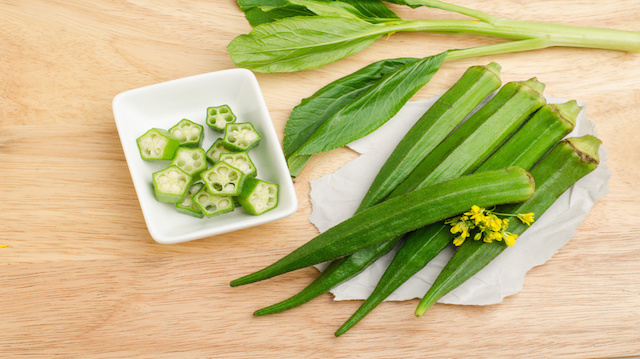
It appears that one of the veggies many of us may turn our noses up at just might be the “it” veggie of the year. Studies are showing that the humble okra is incredibly rich in nutritional properties, and may help prevent diabetes, heart disease, and even weight gain.
However, before you fry up some okra, let’s take a look at the best ways to eat it, and how to get the most benefits.
Also known as “lady’s finger,” okra is a vegetable with high mucilage properties, much like chia seeds and psyllium. Inside the okra plant you’ll find a slimy texture that some might perceive as gross. However, this mucilage is actually the main benefit of the plant, aside from its fiber and vitamin C content.
The mucilage in okra helps bind with excess toxins, cholesterol, and even fat, to help them exit the body without being absorbed. Okra’s soluble fiber also helps with this, and it’s great for lowering blood sugar as a result.
Nutritional stats on okra
One single cup of steamed okra has three grams of fiber, and contains several vitamins and minerals, including vitamin C, folate, and magnesium, along with trace amounts of zinc, calcium, and some B vitamins.
A diet rich in okra may help to fight the following:
- Asthma
- Kidney disease
- High LDL “bad” cholesterol
- High blood sugar
- Nutrient deficiency during pregnancy
- Bloating
- Gas
- Constipation
- Cancer
- Weight gain associated with heart disease and diabetes
How to cook okra for optimal flavor
 Okra has a flavor that somewhat resembles a cross between asparagus and eggplant, so it can be cooked in similar ways as these healthy veggies. Okra tends to have a slimy texture, but you can easily minimize this by cooking it with tomatoes or in a tomato-based sauce. The acidity helps reduce the sliminess, and also adds crispiness without frying. Just avoid cooking your okra in a copper or iron pan, since it can turn your okra black.
Okra has a flavor that somewhat resembles a cross between asparagus and eggplant, so it can be cooked in similar ways as these healthy veggies. Okra tends to have a slimy texture, but you can easily minimize this by cooking it with tomatoes or in a tomato-based sauce. The acidity helps reduce the sliminess, and also adds crispiness without frying. Just avoid cooking your okra in a copper or iron pan, since it can turn your okra black.
Okra also makes a great addition to soups. Perhaps its best-known role is in gumbo, where it is traditionally used as a thickening agent. You can also simply cook it in a skillet with tomato sauce, onions, garlic, and brown or wild rice for a delicious and easy weeknight dinner.
The one cooking method to avoid is frying. Frying foods can lead to the formation of potentially carcinogenic compounds known as acrylamides, which may raise your risk of disease.
Or, don’t cook it at all!
Another way to eat okra is to preserve it like you would other veggies. Since okra contains prebiotic fibers, it will feed good bacteria in your gut, and makes a great addition to sauerkraut or a fermented vegetable mix of your choice. Okra also comes in a pod, so it is easy to pickle and preserve.
What about the leaves?
Don’t forget about the okra leaves if you happen to get your hands on some fresh okra in its whole form. The plant leaves are a great alternative or addition to collards or kale, and can be cooked just like them.
Okra is abundant in September and October, so take advantage of the fresh plant whenever you can, and buy frozen okra during other times of the year. Tell us — do you eat okra? If so, what’s your favorite way to prepare it?
—The Alternative Daily
Sources:
http://www.medicaldaily.com/what-okra-ladys-finger-and-6-benefits-adding-medicinal-vegetable-your-diet-350750
http://www.healthline.com/health/diabetes/okra#Overview1 http://www.nutritionandyou.com/okra.html
http://www.naturalhealth-solutions.net/healthy-eating/okra-is-the-ideal-vegetable-for-weight-loss

